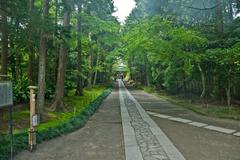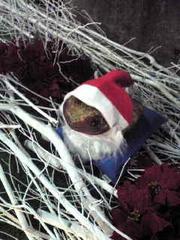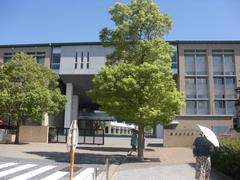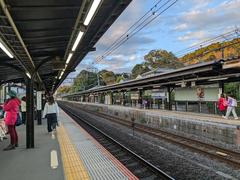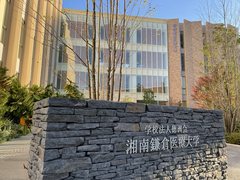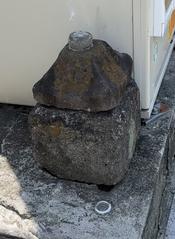Gokuraku-Ji Kamakura: Visiting Hours, Tickets, and Travel Guide
Date: 04/07/2025
Introduction
Gokuraku-Ji Temple (極楽寺), nestled in the tranquil western hills of Kamakura, stands as a testament to Japan’s rich Buddhist heritage, historical resilience, and enduring spirit of compassion. Founded in 1259 during the Kamakura period by the influential regent Hōjō Shigetoki and the revered priest Ninshō, Gokuraku-Ji became both a spiritual sanctuary and a pioneering hub for social welfare and medical care. Over its centuries-long history, the temple has played a significant role in the religious, social, and political life of Kamakura, surviving periods of destruction and renewal.
This guide provides all the essential information for planning your visit to Gokuraku-Ji, including current visiting hours, ticketing, access, must-see features, and cultural insights. Whether you are a spiritual seeker, history enthusiast, or cultural traveler, Gokuraku-Ji offers a peaceful and meaningful experience, enhanced by its seasonal beauty and proximity to other Kamakura landmarks.
For further details, historical context, and visitor tips, consult resources such as Kamakura Info, Japan Travel, and Kamakura Official Guide.
Table of Contents
- Introduction
- Historical Overview
- Visiting Information
- Highlights and Seasonal Attractions
- Nearby Sights and Suggested Itineraries
- Frequently Asked Questions (FAQ)
- Planning and Travel Tips
- Sources and Further Reading
Historical Overview
Origins and Founding Vision
Established in 1259 by Hōjō Shigetoki and the eminent priest Ninshō, Gokuraku-Ji was conceived as both a spiritual center and a place of compassion. Ninshō, a reformer of the Shingon Ritsu sect, was renowned for his humanitarian work, providing care for the sick and marginalized—a mission that set Gokuraku-Ji apart in medieval Japan (Japan Travel). The temple’s name, “Gokuraku,” refers to the Pure Land or Western Paradise of Amida Buddha, reflecting its devotional focus.
Architectural Features
Gokuraku-Ji’s architecture exemplifies Kamakura-period aesthetics, with a distinctive thatched-roof Sanmon (main gate) that harmonizes with the surrounding landscape. The main hall (hondo) houses a statue of Amida Nyorai, and the temple’s understated wooden structures, stone lanterns, and tranquil gardens invite quiet reflection. While the original complex once included 49 sub-temples and extensive welfare facilities, today’s grounds retain elements of this rich legacy (kamakuraguide.com).
Role in Social Welfare
Under Ninshō’s guidance, Gokuraku-Ji established facilities for caring for leprosy patients and the impoverished, providing medical treatment, shelter, and spiritual support to over 60,000 people. This compassionate legacy is a point of pride and historical significance, differentiating Gokuraku-Ji from other Kamakura temples (Japan Travel Navitime).
Historical Events and Restoration
Gokuraku-Ji played an important role during national crises, such as the Mongol invasions of the 13th century, when prayers for protection were offered. The temple endured destruction during the 1333 fall of the Kamakura shogunate but was subsequently rebuilt. Surviving structures like the Kichijo-in and the Treasure Hall reflect its ongoing resilience (Kamakura Info).
Visiting Information
Hours and Admission
- Opening Hours: Generally open daily from 9:00 AM to 4:30 PM. Hours may vary during special events or holidays, so confirm before visiting (Kamakura Official Guide).
- Admission Fee: Standard entry is 300 yen for adults, with discounts for children and seniors. The main temple grounds are free, but access to special exhibition halls or the Treasure Hall may require a separate fee.
Access and Transportation
- Location: 3-6-7 Gokurakuji, Kamakura, Kanagawa 248-0023, Japan
- Public Transport: Take the Enoshima Electric Railway (Enoden) to Gokurakuji Station; the temple is a two-minute walk from the station (Enoden Official).
- From Tokyo: Transfer at Kamakura Station to the Enoden line.
- By Car: Parking is limited; public transport is recommended, especially on weekends or during festival periods.
Facilities and Accessibility
- Grounds: The approach to the temple is gently sloped and paved, with some uneven stone paths and steps.
- Accessibility: Suitable for most visitors, but those with mobility challenges should take care in certain areas.
- Facilities: No on-site café or restrooms; nearest public toilets are at Gokurakuji Station. Vending machines and local eateries are nearby.
Visitor Etiquette and Rituals
- Remove shoes before entering the main hall.
- Dress modestly and maintain a quiet demeanor.
- Photography is permitted in the outer grounds but generally prohibited inside the main hall and sacred areas. Observe posted signs.
- Incense offerings can be made at designated spots.
- Collecting a goshuin (temple stamp) is possible for a small fee (Goshuin Guide).
Highlights and Seasonal Attractions
- Sanmon Gate: The iconic thatched-roof gate, especially photogenic during hydrangea season.
- Main Hall (Hondo): Kamakura-period architecture and sacred atmosphere.
- Gardens: Seasonal cherry blossoms (spring), hydrangeas (early summer), maple leaves (autumn), and serene winter scenes.
- Jizo Statues and Stonework: Scattered throughout the grounds, offering symbolic protection and spiritual comfort.
- Pilgrimage: Gokuraku-Ji is part of the Kamakura 33 Kannon Pilgrimage and 13 Buddha Pilgrimage. Pilgrims may obtain temple seals (goshuin).
Nearby Sights and Suggested Itineraries
- Hase-dera Temple: Known for its Kannon statue and panoramic views.
- Great Buddha (Kamakura Daibutsu) at Kotoku-in: Iconic bronze statue, a short walk or train ride away (Kamakura Daibutsu).
- Joju-in Temple: Nearby, accessible via a scenic staircase, especially during hydrangea season.
- Gokurakuji Hiking Course: Forested trails with coastal vistas (Kamakura Hiking Trails).
- Yuigahama Beach and Main Street: For a blend of history, local life, and seaside relaxation.
Frequently Asked Questions (FAQ)
Q: What are the opening hours of Gokuraku-Ji?
A: 9:00 AM to 4:30 PM daily, with possible seasonal variations.
Q: How much is the entrance fee?
A: 300 yen for adults; discounts available for children and seniors. The general temple grounds are free.
Q: Can I take photographs inside the temple?
A: Photography is permitted in outdoor areas but not inside the main hall or certain sacred spaces.
Q: Are guided tours available?
A: No regular official tours, but local guides and Kamakura walking tours may include Gokuraku-Ji.
Q: Is the temple accessible for visitors with mobility challenges?
A: The approach is paved and gentle, though some stone paths and steps exist.
Planning and Travel Tips
- Best Times to Visit: Early mornings and weekdays for tranquility; June for hydrangea blooms; spring and autumn for mild weather.
- Weather: Kamakura has a temperate climate; prepare for humidity in summer.
- Duration: Allow 30–60 minutes to explore; combine with nearby temples for a half- or full-day itinerary.
- Language: Basic English signage; translation apps are helpful.
- Respect: Observe religious customs and posted notices for a respectful visit.
Visuals
Image 1: The thatched-roof Sanmon gate at Gokuraku-Ji Temple during hydrangea season. Alt text: “Gokuraku-Ji Temple Sanmon gate during hydrangea season, Kamakura.”
Image 2: Main hall interior highlighting the wabi-sabi aesthetic. Alt text: “Main hall interior of Gokuraku-Ji Temple in Kamakura with tatami flooring and wooden beams.”
Image 3: Stone path lined with cherry blossoms. Alt text: “Cherry blossom-lined path leading to Gokuraku-Ji Temple, Kamakura.”
Further Reading and Sources
- Kamakura Info
- Japan Travel
- Kamakura Guide
- Kamakura Official Guide
- Trip Kamakura
- Japan Travel Navitime
Plan Your Visit
Gokuraku-Ji Temple offers a serene, culturally rich, and accessible experience for all visitors to Kamakura. To maximize your visit, check for the latest updates, consider combining your trip with other historical sites, and embrace the tranquil ambiance and spiritual heritage that Gokuraku-Ji embodies. For personalized travel assistance, event updates, and audio guides, download the Audiala app and connect with us on social media for ongoing inspiration and insights.
